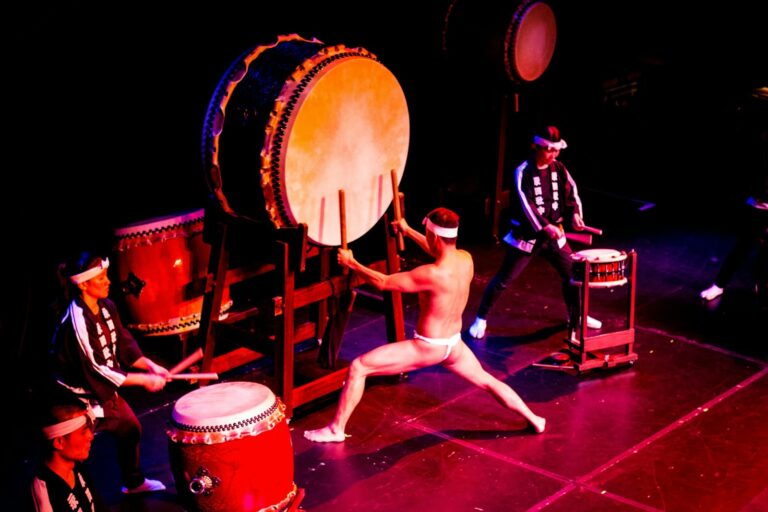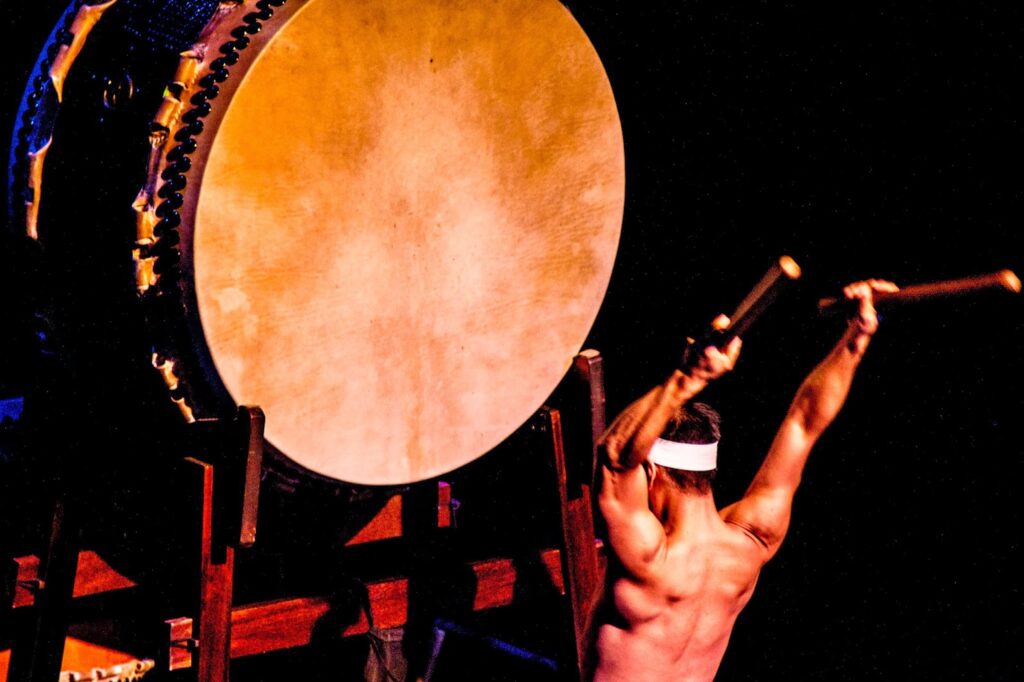 |
| Kiyoshi Nagata performs on the massive O-hirado daiko. (Photo: Cody Lanktree) |
The sweat appeared, glistening between his shoulder blades, five minutes into the piece.
It was only half over.
The stage lights burned like the tropical sun of an ancient Japanese village. I was transported. The sheer spectacle of his engagement with this huge drum towering over him as he wielded baseball-sized sticks was mesmerizing. Pointing his sticks toward the sky, he sought a mystical connection with the music. He was deeply crouching the whole time, legs firmly planted, torso tensed to allow his entire weight to engage the wooden bachi (sticks) with the massive drum. The BOOM of each stroke resonated throughout the Studio Theatre like a tangible force, touching every audience member. More drums joined.
 |
| (Photo: Cody Lanktree) |
More sweat. Now a small trickle down the spine.
He continued. And then he stepped up the tempo. Frenzy. Ferocity. This was for real.
Now I know why he was only wearing a loin cloth.
When it was over, Kiyoshi Nagata turned slowly to face the audience, and took a humble bow as his muscles trembled. The audience went nuts. What a show!
Nagata Shachu, named after its founder Kiyoshi Nagata, is Canada’s premier taiko ensemble. Its mandate is as much about creating new works as it is about preserving the old. The five member group has been thrilling audiences in Canada, the U.S. and Europe with its thunderous and mesmerizing
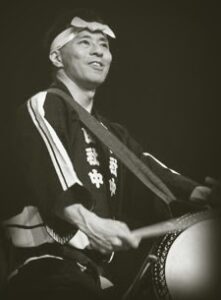 |
| Kiyoshi Nagata |
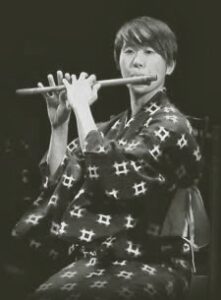 |
| Heidi Chan |
 |
| Tony Nguyen |
 |
| Akemi Akachi(Photo: nagatashachu.com) |
Much like jazz drummer and showman Buddy Rich would seek to recreate an entire mood and excitement for the audience, while showing off his prowess and endurance, the Nagata Shachu team showed off their joy, commitment, physical prowess and precision throughout tonight’s show. We saw each of the members let loose and show off their Taiko drumming skills.
Every selection of tonight’s performance had its own shape and compositional integrity. Things were kept fresh and exciting throughout the show using a number of tactics: build-up of energy using increasing tempo and volume, sudden changes in rhythm, instrument switches, and visually appealing body movements called kata that turn the time and space between strokes of the drum into a precise, beautiful, controlled form of dance. Nagata was the composer of every selection but one, undoubtedly building upon traditions and ideas from other taiko ensembles around the world.
What made tonight’s performance exceptional was seeing the musicians’ joyful skill of concentration, the raw physical fitness, and the musical precision. Some highlights are below.
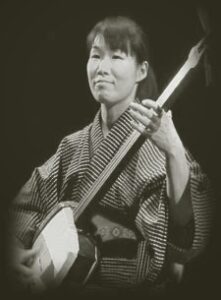 |
| Aki Takahashi plays the 3-stringed shamisen. (Photo: nagatashachu.com) |
Tsugaru Tanto Bushi, a traditional arranged by Aki Takahashi, was a Japanese folk song in which people would often make up the lyrics as they were singing it. Today, this traditional piece which uses the three-stringed shamisen, was accompanied in a novel way, with a Japanese taiko set.
Koku composed by Kiyoshi Nagata, was performed on the massive O-hirado daiko. The first half of the song was accompanied by three taiko and a gong. The second half was improvised, allowing the soloist to play freely and unbounded, and to display unbridled strength and endurance. Koku, or ‘Empty Sky’, suggests the idea of achieving a higher state of being when playing this physically demanding piece.
The final number was Miyake, a traditional piece arranged by Kiyoshi Nagata. This drumming style, where the players were crouching very low and swinging back and forth in an elongated and strenuous stance, gave each player an opportunity for a freestyle solo between the choruses.
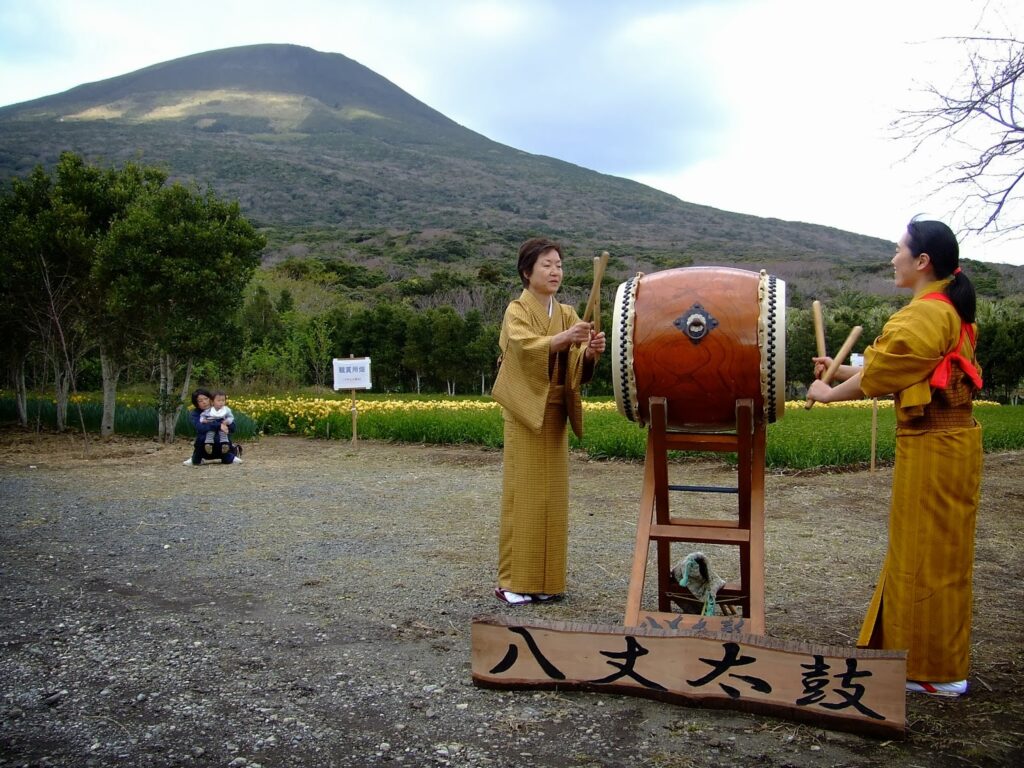 |
| Traditional taiko drumming in Japan |
A Little History
The modern taiko (drum) ensemble, commonly known as kumi-daiko, originated during the post-war era in Japan. Daihachi Oguchi was a gigging jazz drummer who discovered an old score of traditional Japanese drum notation. He worked to translate it and then set out to perform it in honour of a local shrine. It was Oguchi that was inspired to re-interpret, or jazz up, the music not only by enhancing the rhythms, but by combining several taiko and transforming the experience into an act of teamwork. The art of kumi-daiko has now been adapted by thousands of Japanese cultural groups, supported by municipalities throughout Japan and the exciting kumi-daiko style has spread to multi-cultural groups across the world.
There is an element of devotion involved in this art form. From the earliest days, young Japanese recruits had to be willing to devote their entire lifestyle to taiko playing. Beyond the drumming, there was a rigorous set of training exercises including long-distance running. In 1975 one of the first taiko groups to perform in the United States prepared for their first performance by running the Boston Marathon while wearing their traditional uniforms.
The excerpt below was taken from the Hamilton show on September 28, 2013.
The selection is titled Araumi (Stormy Sea) composed by Kiyoshi Nagata
A haunting shinobue (bamboo flute) melody accompanied by the large O-Daiko drum and a small Buddhist bell begins this piece representing the calm before the storm. The frantic playing of the high–pitched shime daiko, punctuated by deep drumbeats portrays the stormy sea in full force.
Nagata Shachu produces its own annual concert where it premieres new works and collaborates with guest artists.

